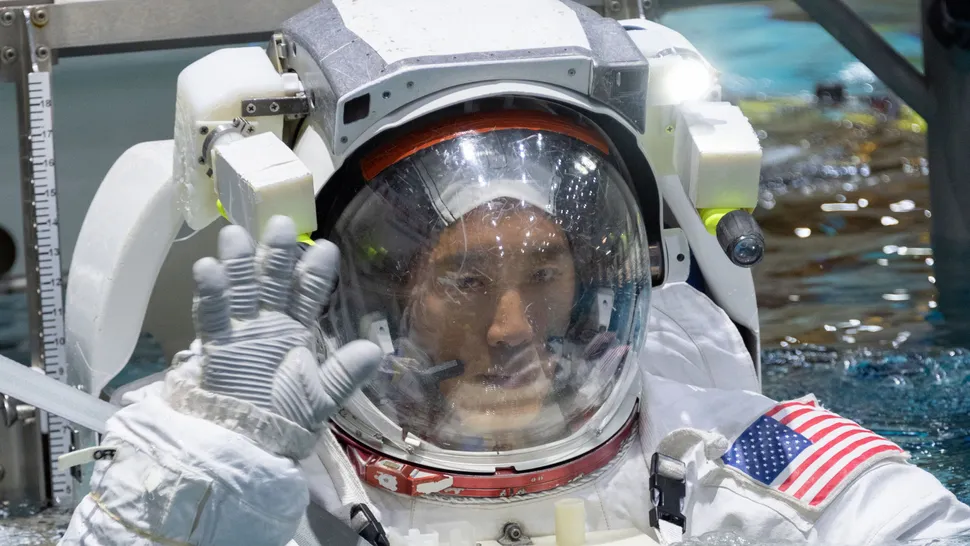NASA astronaut Jonny Kim, a former U.S. Navy SEAL, will be the first Korean-American astronaut to perform a long-duration mission.
Kim will spend eight months on the International Space Station (ISS), starting in March 2025, as part of the Expedition 72 and 73 crews, NASA officials announced Wednesday (Aug. 28). He will fly to space aboard the Russian Soyuz MS-27 spacecraft alongside Sergey Ryzhikov and Alexey Zubritsky; the cosmonauts’ assignments were announced in TASS (Russian state media) last week via Roscosmos, the Russian space agency.
“I’m incredibly honored to represent … our continued commitment to international collaboration and scientific discovery at NASA,” Kim posted on X, formerly Twitter, on Thursday (Aug. 29). “Teamwork is one of the most important ingredients of success in mission-critical environments such as space.”
While most U.S. astronauts fly to space aboard American spacecraft these days, Kim will fly on Soyuz, like some other NASA crewmembers have in the past, for backup and policy reasons. Roscosmos cosmonauts also do seat exchanges on U.S. spacecraft, with Aleksandr Gorbunov as the latest one, assigned to SpaceX Crew-9 launching on Sept. 24. That said, Crew-9’s astronauts aboard Crew Dragon will need to reduce from four members to two due to complications with the Boeing Starliner mission.
Crew-9 will need to create room in its capsule to bring two other ISS-based NASA astronauts home. Those astronauts were originally meant to return home on the Starliner capsule that brought them to the station, but Starliner‘s return with astronauts on board was deemed an unacceptable risk this month due to problems with the spacecraft’s thruster system.
Starliner astronauts Butch Wilmore and Suni Williams will move to Crew Dragon and occupy two of the seats for the ride to Earth in February 2025, with Gorbunov and U.S. Space Force astronaut Nick Hague flying to space on Crew-9 and flying home with the Starliner astronauts.
Two original Crew-9 members will move to another flight: NASA’s Zena Cardman, another “Turtles” member who has not been to space, and shuttle astronaut Stephanie Williams will be reassigned at a later point, NASA officials wrote on Friday (Aug. 30).
Crew-9’s launch was delayed until at least Sept. 24 (from Aug. 18) to give extra time for reconfiguring the spacecraft for two crew members, instead of four. Crew-8, currently docked at ISS, was delayed in its departure as the crew schedule requires a handover period between ISS crews.
That said, Crew-9’s Sept. 24 launch date is not a lock yet. SpaceX’s Falcon 9 rocket fleet may be grounded, including for all human launches, after a rocket caught fire and tipped over during landing Wednesday (Aug. 28) following a successful SpaceX Starlink satellite launch. (A different variant of Falcon 9 carries Crew Dragon to the ISS.)
SpaceX has not yet revealed the impact on crew launch activities, which in the near future include Crew-9 to the ISS and the private Polaris Dawn mission to Earth orbit. In a statement to the Washington Post, NASA officials said they are involved in the investigation and the launching schedule will be determined.
Starliner, Crew-8 and Crew-9 delays have had ripple-on effects on the rest of the space station’s operations and crew schedules remain somewhat in flux as a result. That said, neither NASA nor TASS has stated why Soyuz MS-27 will be for eight months instead of the usual six.
As ISS flight engineer, Kim will “conduct scientific investigations and technology demonstrations to help prepare the crew for future space missions and provide benefits to people on Earth,” NASA officials said in the statement announcing his assignment to a space mission.
His ground experience with NASA includes Expedition 65 lead operations officer, operations liaison for the T-38 jet used for astronaut flight training, and space station capcom engineer.
Kim, a U.S. Navy lieutenant commander, is on active duty as both a naval aviator and a flight surgeon under the aeromedical dual designation program. The program “is typically for medical officers to seek a dual qualification in naval aviation to better understand the effects of flight on the human system,” according to the U.S. Navy.
Kim was born in Los Angeles where his father, a South Korean immigrant, managed a liquor store. The store was damaged in 1992, along with a reported 2,200 other Korean businesses in the neighborhood due to protests in the community.
The protests erupted after four Los Angeles police officers were acquitted following the beating of Rodney King, a Black man who was pulled over on a freeway in 1991 after a high-speed pursuit. (The roots of targeting the Korean community are complex, but in part appear to be linked to limited resources for marginalized communities in Los Angeles including African-Americans and Korean-Americans, according to NBC.)
“It was a very stressful time,” Kim told Stars and Stripes in 2020 of the effect of these protests on his community.
Kim’s Navy service includes enlisting as a SEAL and serving in Iraq across two deployments and more than 100 combat missions, according to Stars and Stripes. His Navy awards include a Silver Star and a Bronze Star with “V” device. The “V” designating duties of valor.
He formerly held internships at the Harvard Affiliated Emergency Medicine Residency program at Massachusetts General Hospital, as well as Brigham and Women’s Hospital. He holds a bachelor’s degree in mathematics from the University of San Diego and a medical degree from Harvard Medical School in Boston.
Kim will be the second Korean-American in orbit following the spaceflights of U.S. Air Force pilot and NASA astronaut Mark L. Polansky, who also has Korean ancestry, according to Purdue University. Polansky flew three space shuttle missions: STS-98 in 2001, STS-116 in 2006 and STS-127 in 2009.
Source: https://www.space.com/nasa-astronaut-jonny-kim-iss-korean-american



